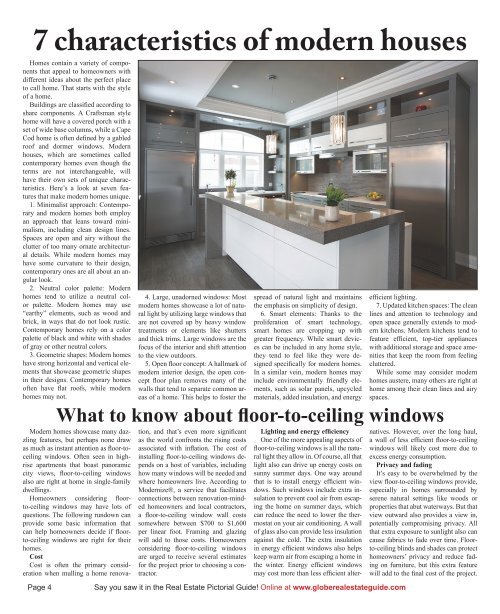Create successful ePaper yourself
Turn your PDF publications into a flip-book with our unique Google optimized e-Paper software.
7 characteristics of modern houses<br />
Homes contain a variety of components<br />
that appeal to homeowners with<br />
different ideas about the perfect place<br />
to call home. That starts with the style<br />
of a home.<br />
Buildings are classified according to<br />
share components. A Craftsman style<br />
home will have a covered porch with a<br />
set of wide base columns, while a Cape<br />
Cod home is often defined by a gabled<br />
roof and dormer windows. Modern<br />
houses, which are sometimes called<br />
contemporary homes even though the<br />
terms are not interchangeable, will<br />
have their own sets of unique characteristics.<br />
Here’s a look at seven features<br />
that make modern homes unique.<br />
1. Minimalist approach: Contemporary<br />
and modern homes both employ<br />
an approach that leans toward minimalism,<br />
including clean design lines.<br />
Spaces are open and airy without the<br />
clutter of too many ornate architectural<br />
details. While modern homes may<br />
have some curvature to their design,<br />
contemporary ones are all about an angular<br />
look.<br />
2. Neutral color palette: Modern<br />
homes tend to utilize a neutral color<br />
palette. Modern homes may use<br />
“earthy” elements, such as wood and<br />
brick, in ways that do not look rustic.<br />
Contemporary homes rely on a color<br />
palette of black and white with shades<br />
of gray or other neutral colors.<br />
3. Geometric shapes: Modern homes<br />
have strong horizontal and vertical elements<br />
that showcase geometric shapes<br />
in their designs. Contemporary homes<br />
often have flat roofs, while modern<br />
homes may not.<br />
4. Large, unadorned windows: Most<br />
modern homes showcase a lot of natural<br />
light by utilizing large windows that<br />
are not covered up by heavy window<br />
treatments or elements like shutters<br />
and thick trims. Large windows are the<br />
focus of the interior and shift attention<br />
to the view outdoors.<br />
5. Open floor concept: A hallmark of<br />
modern interior design, the open concept<br />
floor plan removes many of the<br />
walls that tend to separate common areas<br />
of a home. This helps to foster the<br />
spread of natural light and maintains<br />
the emphasis on simplicity of design.<br />
6. Smart elements: Thanks to the<br />
proliferation of smart technology,<br />
smart homes are cropping up with<br />
greater frequency. While smart devices<br />
can be included in any home style,<br />
they tend to feel like they were designed<br />
specifically for modern homes.<br />
In a similar vein, modern homes may<br />
include environmentally friendly elements,<br />
such as solar panels, upcycled<br />
materials, added insulation, and energy<br />
efficient lighting.<br />
7. Updated kitchen spaces: The clean<br />
lines and attention to technology and<br />
open space generally extends to modern<br />
kitchens. Modern kitchens tend to<br />
feature efficient, top-tier appliances<br />
with additional storage and space amenities<br />
that keep the room from feeling<br />
cluttered.<br />
While some may consider modern<br />
homes austere, many others are right at<br />
home among their clean lines and airy<br />
spaces.<br />
What to know about floor-to-ceiling windows<br />
Modern homes showcase many dazzling<br />
features, but perhaps none draw<br />
as much as instant attention as floor-toceiling<br />
windows. Often seen in highrise<br />
apartments that boast panoramic<br />
city views, floor-to-ceiling windows<br />
also are right at home in single-family<br />
dwellings.<br />
Homeowners considering floorto-ceiling<br />
windows may have lots of<br />
questions. The following rundown can<br />
provide some basic information that<br />
can help homeowners decide if floorto-ceiling<br />
windows are right for their<br />
homes.<br />
Cost<br />
Cost is often the primary consideration<br />
when mulling a home renovation,<br />
and that’s even more significant<br />
as the world confronts the rising costs<br />
associated with inflation. The cost of<br />
installing floor-to-ceiling windows depends<br />
on a host of variables, including<br />
how many windows will be needed and<br />
where homeowners live. According to<br />
Modernize®, a service that facilitates<br />
connections between renovation-minded<br />
homeowners and local contractors,<br />
a floor-to-ceiling window wall costs<br />
somewhere between $700 to $1,600<br />
per linear foot. Framing and glazing<br />
will add to those costs. Homeowners<br />
considering floor-to-ceiling windows<br />
are urged to receive several estimates<br />
for the project prior to choosing a contractor.<br />
Lighting and energy efficiency<br />
One of the more appealing aspects of<br />
floor-to-ceiling windows is all the natural<br />
light they allow in. Of course, all that<br />
light also can drive up energy costs on<br />
sunny summer days. One way around<br />
that is to install energy efficient windows.<br />
Such windows include extra insulation<br />
to prevent cool air from escaping<br />
the home on summer days, which<br />
can reduce the need to lower the thermostat<br />
on your air conditioning. A wall<br />
of glass also can provide less insulation<br />
against the cold. The extra insulation<br />
in energy efficient windows also helps<br />
keep warm air from escaping a home in<br />
the winter. Energy efficient windows<br />
may cost more than less efficient alternatives.<br />
However, over the long haul,<br />
a wall of less efficient floor-to-ceiling<br />
windows will likely cost more due to<br />
excess energy consumption.<br />
Privacy and fading<br />
It’s easy to be overwhelmed by the<br />
view floor-to-ceiling windows provide,<br />
especially in homes surrounded by<br />
serene natural settings like woods or<br />
properties that abut waterways. But that<br />
view outward also provides a view in,<br />
potentially compromising privacy. All<br />
that extra exposure to sunlight also can<br />
cause fabrics to fade over time. Floorto-ceiling<br />
blinds and shades can protect<br />
homeowners’ privacy and reduce fading<br />
on furniture, but this extra feature<br />
will add to the final cost of the project.<br />
Page 4<br />
Say you saw it in the <strong>Real</strong> <strong>Estate</strong> Pictorial <strong>Guide</strong>! Online at www.globerealestateguide.com
















